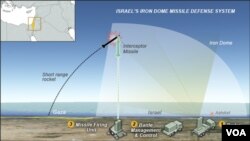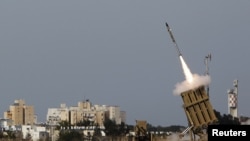Israel's Iron Dome missile shield appears to be passing its first major test, stopping hundreds of Gaza rockets from hitting Israeli communities in recent days. But that test also has revealed several weaknesses in the year-old U.S.-backed system.
The Israeli military said Tuesday that Iron Dome has intercepted at least 389 rockets since Israel began its offensive against Gaza militants November 14. An Israeli defense official said that figure represents at least 80 percent of all Gaza rockets targeted by the system over the period.
‘Impressive’ Results
Robert Powell, a Middle East analyst with the Economist Intelligence Unit in New York, said Iron Dome has proven "mightily impressive," given that it only became operational last year. He said the missile defense program has blocked short-range rockets that typically are difficult to intercept.
Iron Dome was developed by Rafael Defense Systems, an Israeli state-run defense company, with support from two other Israeli firms, state-owned Elta Systems and privately held mPrest Systems.
Israel began developing the shield after the Lebanese militant group Hezbollah fired thousands of rockets at northern Israeli communities in a brief 2006 war. Israeli authorities deployed the first Iron Dome battery in southern Israel last year to act against years of rocket fire from Gaza.
How Iron Dome Works
Each battery has three components that operate in sequence: a radar detection unit that picks up the launch of a rocket; a management center that predicts where the rocket will land and determines whether it should be intercepted, and a missile firing unit that fires the interceptor missile.
Since 2011, Israel has deployed five Iron Dome batteries in the south and center of the country. They are designed to shoot down rockets with a range of five to 70 kilometers. If the shield deems a rocket to pose no threat to civilian or military sites, it allows that rocket to land on open ground.
Israel positioned the 5th battery on the outskirts of Tel Aviv on November 17, two days after the country’s commercial capital was targeted by Gaza rockets for the first time.
System Upgrades
Rafael Defense Systems vice president of business development Oron Oriol said the Tel Aviv unit is part of an upgraded 2nd batch of Iron Dome batteries.
“The [new] version of the battery has some improvements in the man-machine interface, in the capabilities of the radar and the [interceptor] missiles,” he said.
Oriol said Iron Dome has the capability to deal with the quantity of rockets fired at Israel so far.
“The system was designed to deal with [rocket] salvos. I can't tell you if [militants] will be capable of overwhelming the system or not. But, you can see the [interception] results already [achieved].”
Those results also have exposed some technical problems with Iron Dome.
Malfunctions and Debris
Israeli media said the system suffered a brief malfunction at the time that a Gaza rocket hit an apartment building in the Israeli town of Kiryat Malachi last Thursday, killing three residents.
Shrapnel from successful mid-air interceptions also has fallen onto populated areas, causing some injuries and property damage.
Oriol said Rafael employees are working “day and night” to learn from every incident. He also said falling debris is inevitable because interceptors are designed to destroy rocket warheads, not entire rockets.
“Pieces of metal will come to the ground because this is gravity … and we can’t control it,” said Oriol. “This is why people should be in shelters or in buildings and not outside because they can [get] hurt.”
Another weakness of Iron Dome is tactical.
Limits as a Defensive Tool
EIU analyst Powell said the system’s effectiveness is limited to reducing the impact of militant retaliation for Israeli operations.
“In terms of Israel's choice of [offense] - naval, air, ground troops - Iron Dome does not really play a role. The system itself is not a game changer in terms of [ability] to hit Hamas targets within Gaza.”
Powell said Israeli Prime Minister Benjamin Netanyahu still faces a choice between continuing “moderately effective” air strikes and a ground invasion to “wipe out” Hamas.
“[An invasion] means potentially large numbers of [troop] losses and enormous expense when there is a general election [in January]. It seems he is not willing to do that, especially [considering] the budget deficit, which is increasingly worrying.”
High Costs
Israel already has spent $560 million on Iron Dome, with the United States providing $275 million of the funds. The Israeli government plans to spend another $190 million to deploy more batteries.
Each firing of an interceptor missile costs the Israeli government tens of thousands of dollars, according to the defense ministry.
But Iron Dome interceptions also help to prevent Israeli fatalities that could pressure the government into a much more costly ground war.
“It is not the cost of the interceptor that counts,” said Oriol. “What counts is what one interceptor can really save, and the cost of the damage [that] one rocket can really cause to the population.”
The Israeli military said Tuesday that Iron Dome has intercepted at least 389 rockets since Israel began its offensive against Gaza militants November 14. An Israeli defense official said that figure represents at least 80 percent of all Gaza rockets targeted by the system over the period.
‘Impressive’ Results
Robert Powell, a Middle East analyst with the Economist Intelligence Unit in New York, said Iron Dome has proven "mightily impressive," given that it only became operational last year. He said the missile defense program has blocked short-range rockets that typically are difficult to intercept.
Iron Dome was developed by Rafael Defense Systems, an Israeli state-run defense company, with support from two other Israeli firms, state-owned Elta Systems and privately held mPrest Systems.
Israel began developing the shield after the Lebanese militant group Hezbollah fired thousands of rockets at northern Israeli communities in a brief 2006 war. Israeli authorities deployed the first Iron Dome battery in southern Israel last year to act against years of rocket fire from Gaza.
How Iron Dome Works
Each battery has three components that operate in sequence: a radar detection unit that picks up the launch of a rocket; a management center that predicts where the rocket will land and determines whether it should be intercepted, and a missile firing unit that fires the interceptor missile.
Since 2011, Israel has deployed five Iron Dome batteries in the south and center of the country. They are designed to shoot down rockets with a range of five to 70 kilometers. If the shield deems a rocket to pose no threat to civilian or military sites, it allows that rocket to land on open ground.
Israel positioned the 5th battery on the outskirts of Tel Aviv on November 17, two days after the country’s commercial capital was targeted by Gaza rockets for the first time.
System Upgrades
Rafael Defense Systems vice president of business development Oron Oriol said the Tel Aviv unit is part of an upgraded 2nd batch of Iron Dome batteries.
“The [new] version of the battery has some improvements in the man-machine interface, in the capabilities of the radar and the [interceptor] missiles,” he said.
Oriol said Iron Dome has the capability to deal with the quantity of rockets fired at Israel so far.
“The system was designed to deal with [rocket] salvos. I can't tell you if [militants] will be capable of overwhelming the system or not. But, you can see the [interception] results already [achieved].”
Those results also have exposed some technical problems with Iron Dome.
Malfunctions and Debris
Israeli media said the system suffered a brief malfunction at the time that a Gaza rocket hit an apartment building in the Israeli town of Kiryat Malachi last Thursday, killing three residents.
Shrapnel from successful mid-air interceptions also has fallen onto populated areas, causing some injuries and property damage.
Oriol said Rafael employees are working “day and night” to learn from every incident. He also said falling debris is inevitable because interceptors are designed to destroy rocket warheads, not entire rockets.
“Pieces of metal will come to the ground because this is gravity … and we can’t control it,” said Oriol. “This is why people should be in shelters or in buildings and not outside because they can [get] hurt.”
Another weakness of Iron Dome is tactical.
Limits as a Defensive Tool
EIU analyst Powell said the system’s effectiveness is limited to reducing the impact of militant retaliation for Israeli operations.
“In terms of Israel's choice of [offense] - naval, air, ground troops - Iron Dome does not really play a role. The system itself is not a game changer in terms of [ability] to hit Hamas targets within Gaza.”
Powell said Israeli Prime Minister Benjamin Netanyahu still faces a choice between continuing “moderately effective” air strikes and a ground invasion to “wipe out” Hamas.
“[An invasion] means potentially large numbers of [troop] losses and enormous expense when there is a general election [in January]. It seems he is not willing to do that, especially [considering] the budget deficit, which is increasingly worrying.”
High Costs
Israel already has spent $560 million on Iron Dome, with the United States providing $275 million of the funds. The Israeli government plans to spend another $190 million to deploy more batteries.
Each firing of an interceptor missile costs the Israeli government tens of thousands of dollars, according to the defense ministry.
But Iron Dome interceptions also help to prevent Israeli fatalities that could pressure the government into a much more costly ground war.
“It is not the cost of the interceptor that counts,” said Oriol. “What counts is what one interceptor can really save, and the cost of the damage [that] one rocket can really cause to the population.”










